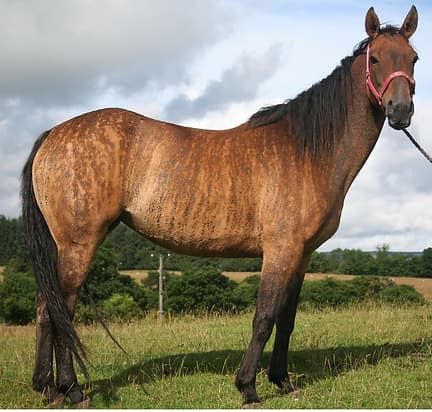IP/Brindle (IP)
Gene or Region: IKBKG
Reference Variant: C (N)
Mutant Variant: T (IP)
Affected Breeds: One Family of Unreported Breed
Research Confidence: High Confidence - The same mutation has been associated with IP in a human family
Explanation of Results: IP/IP = homozygous for Incontinentia Pigmenti (IP), lethal IP/n Female= heterozygous for Incontinentia Pigmenti (IP), affected female IP/n Male= heterozygous for Incontinentia Pigmenti (IP), lethal male n/n = no variant detected
Incontinentia Pigmenti in Horses: A Comprehensive Guide to the Brindle-Like Genetic Condition
Incontinentia pigmenti (IP) is a variant of the IKBKG gene on the X chromosome, causing in weepy skin lesions present at birth. IP is sex-linked and homozygous lethal, with homozygous female (X-IP/X-IP) and hemizygous male (X-IP/Y) foals aborted. As an affected foal ages, the skin lesions develop into warty areas often accompanied by hair loss. The rare hair regrowth has an abnormal wooly appearance. From birth, the overall haircoat has streaks of darker and lighter hair, similar to the brindle coat color in other species. The original research paper also mentioned abnormalities of tooth, hoof, and ocular development, though no specific details were provided, and affected animals were able to successfully reproduce.
While IP gives the appearance of a brindle coat color resulting from the underlying skin disorder, there have been other non-disordered reports of brindling in the horse. Some cases have been found to be the result of chimerism, where two embryos of different coat colors have merged during development to form one animal. These animals display a striking coat pattern that cannot be transmitted to offspring. More recent research discovered a heritable form of brindle without associated skin lesions within the same family affected by IP, termed brindle 1 (BR1).
Gene Information
IKBKG is a protein kinase that serves as a member of a protein complex involved in inflammation, immunity, and cell survival. The IP mutation is a single base change that leads to a premature stop and thus truncation of the protein. Due to the importance of this gene to development and its location on the X chromosome, male embryos with IP are not viable, and thus are lost early on in pregnancy. During development, female X chromosomes are randomly inactivated, which leads to populations of cells with normal IKBKG function (and thus no skin lesions), and populations of cells with the abnormal protein (which display skin lesions). In humans, research has shown that these abnormal cells are eliminated with age, resulting in a greater number of normal cells and a resolution of skin symptoms.
More Horse Color Genetics
Cream
Cream (CR) is a dilution that is characterized by diluting or lightening both black-based and red-based horses. A single CR allele lightens red pigment to Palomino but does not overtly affect Black pigment. Two CR alleles results in extreme dilution of the hair, skin, and eyes of any color, though black-based horses tend to retain more pigment than red-based horses.
